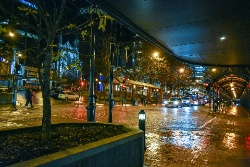Fire Service to standardise response to alarm call
Fire Service to standardise response to alarm calls
The Fire Service is changing the way it responds to some false alarm callouts and believes the result could mean fewer traffic snarl ups in major cities.
The organisation is following international best practice and standardising the number of appliances it sends to investigate an automatic alarm from low risk buildings with sprinklers installed.
Fire Service National Commander, Mike Hall, says almost all the automatic alarm calls from buildings with sprinklers installed are false alarms. On the rare occasions when there is a fire, the sprinklers give people time to evacuate safely and prevent the fire from taking hold and spreading.
Mr Hall says senior fire officers have reviewed all buildings with sprinklers installed to determine their fire risk, and the potential risk to life. Buildings housing vulnerable people such as rest homes and hospitals have a higher risk of loss of life. Buildings that contain hazardous or flammable materials have a higher risk of rapid fire spread or loss of life. These higher risk buildings are not affected by the change in response.
“However, an initial alarm from buildings identified as low risk will be responded to by two fire appliances as a routine investigation measure. For many brigades throughout New Zealand already this is already the standard response and we are now extending it to the rest of the country. If there is a confirming 111 call or any other indication of a fire then, of course, more appliances would be sent immediately,’ he said.
“Sending fewer appliances to investigate alarm activations should result in less traffic congestion and less disruption to local businesses. For instance, there are around seven false alarm calls from sprinklered buildings each week in Auckland city and in the past we have sent up to six appliances to each call. Sending fewer will help keep traffic flowing and also reduces the very real risk of traffic accidents on route to the alarm,” he said.
In addition, the change makes better use of Fire Service resources, particularly firefighters’ time - allowing more community fire safety and education activities, training and risk management work.
“Of the 25,000 automatic alarm calls from buildings with sprinklers over a five-year period only nine calls (0.03%) involved serious fires in a building that is affected by this change in response. There are invariably multiple 111 calls to any serious fire which means we immediately dispatch more trucks, or we call for back up on arrival if we need it. This is exactly what happened in these instances. There is no justification for continuing to send several unnecessary appliances to an initial alarm in a low risk building,” said Mr Hall.
The change takes effect on 29 April.
ENDS


 Gordon Campbell: On The Hamas Ceasefire Offer, And Mark Mitchell’s Incompetence
Gordon Campbell: On The Hamas Ceasefire Offer, And Mark Mitchell’s Incompetence Wellington Office of the Mayor: Mayor Responds To Housing Minister’s District Plan Decision
Wellington Office of the Mayor: Mayor Responds To Housing Minister’s District Plan Decision Stats NZ: Have Your Say On Modernising The Census
Stats NZ: Have Your Say On Modernising The Census NZ Government: Therapeutic Products Act To Be Repealed
NZ Government: Therapeutic Products Act To Be Repealed The Treasury: Interim Financial Statements Of The Government For Nine Months Ended 31-3-2024
The Treasury: Interim Financial Statements Of The Government For Nine Months Ended 31-3-2024  Government: New Zealand Sign Language Week An Opportunity For Anyone To Sign
Government: New Zealand Sign Language Week An Opportunity For Anyone To Sign ACT New Zealand: Investment In Prisons Delivers On ACT Commitment
ACT New Zealand: Investment In Prisons Delivers On ACT Commitment


